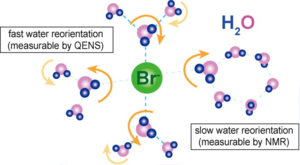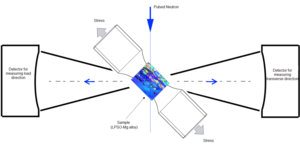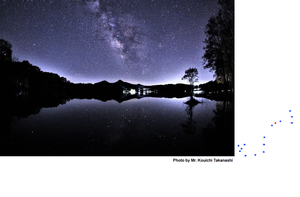J-PARC News August 2023 (Issue #220)
■ Water molecules around a bromide ion show a rapid reorientation of hydrogen-bonds.
-Neutron Observation of Water Molecule Dynamics in Semiclathrate Hydrate -(July 26th)
It is already known that ions in the aqueous solution can promote or suppress the reorientation of hydrogen bonds of water. However, how ions and water molecules interact inside solid electrolytes has not been elucidated.
A research group from Osaka University, Kobe University, and Kyoto University measured QENS of tetrabutylammonium bromide (TBAB) semiclathrate hydrate, using the neutron spectrometer "DNA" at the Materials and Life Science Experimental Facility (MLF) in the J-PARC to elucidate the dynamics of water in TBAB the semiclathrate hydrate.
Detailed analysis revealed that a high proton conductivity of the TBAB semiclathrate hydrate originated from the rapid reorientation of water molecules around the bromide ion in a much shorter time than had been expected from the other experimental result.
The research contributes to new design guidelines for developing battery materials and sensors that utilize water molecules in the framework of semiclathrate hydrates. The search for ions that promote the migration of hydrogen ions (i.e., increase their conductivity) will be a key to further developments.
For more details, please visit our home page.
https://j-parc.jp/c/press-release/2023/07/26001183.html (only in Japanese)
DOI: https://doi.org/10.1063/5.0157560
■Elucidation of Strengthening Mechanism of High-strength Magnesium Alloy Developed in Japan
-In situ neutron diffraction experiment revealed the behavior of each constituent phase during deformation-(August 15th)
A research group from JAEA, J-PARC, and Kumamoto University has elucidated the mechanism by which a high-strength magnesium alloy (Mg97Zn1Y2 alloy, hereafter referred to LPSO-Mg alloy) was greatly enhanced in strength by hot-extrusion process.
The high-strength LPSO-Mg alloy developed by Kumamoto University consists of the α matrix (αMg) with HCP crystal structure and a long-period stacking ordered phase (LPSO phase). LPSO-Mg alloy is expected to be applied to structural materials in automobiles and aircraft due to the light-weight and the significant increase in the strength by hot-extrusion. However, the mechanism of the significant increase in the strength was not understood well.
Therefore, in this study, the research group conducted in situ neutron diffraction measurements during deformation of LPSO-Mg alloy using the high-performance engineering materials diffractometer "TAKUMI" at MLF in J-PARC. Specimens of LPSO-Mg alloy extruded at different extrusion ratios at high temperatures were examined. Taking advantage of the neutron’s ability to penetrate deep into a sample and see the internal atomic arrangement, the research group succeeded in measuring the behavior of each constituent phase in the LPSO-Mg alloy in detail. The developed in situ neutron diffraction measurement and analysis method, which can be used without interrupting the deformation process, also enabled detailed observations for the first time.
The analysis showed that αMg behaved as the softer phase and the LPSO phase behaved as the harder phase in the alloy, but both were strengthened by hot-extrusion. At the specimen with a low extrusion ratio, the αMg phase composed of dual-microstructures with different morphologies, in which both increased the strength largely, increasing the overall strength of the alloy. The strength increase of αMg phase surprisingly exceeded the strength increase of the LPSO phase.
Insights from this study suggests that when microstructures with different morphologies exist within a particular constituent phase of the alloy, we should also consider the individual stresses of the microstructure, not as the phase average only. In the development of magnesium alloys, controlling the microstructural morphology of the αMg opens up the possibility of simultaneously improvement of strength and ductility, which will provide significant guidance for future design and optimization of high-temperature processing.
For more details, please visit our home page.
https://j-parc.jp/c/press-release/2023/08/15001190.html (only in Japanese)
DOI: 10.1016/j.actamat.2023.119029
■J-PARC Hello Science “Muon Now Cooling” on July 28th
This month's Hello Science was presented by Dr. Tsutomu MIBE of the Hadron Section, who introduced the muon cooling technique and the precise measurement of the anomalous magnetic moment ("g-2") performed with this technique.
Conventionally, particle physics research has evolved through a process of first developing a theory that expresses the observed facts, then comparing the predictions based on that theory with new experimental results, and revising the theory if there is a discrepancy. Today, almost all predictions of the standard model of particle physics agree with experimental results. However, some phenomena, such as the disappearance of antimatter from the universe, cannot be explained. In April 2021, the Fermi National Accelerator Laboratory announced that they had found an unresolved discrepancy between experimental values of the muon g-2 and the standard model, which could be a sign of an unknown theory.
Scientists at J-PARC are preparing to measure g-2 using new experimental techniques.
They have succeeded in producing muonium, a bound state between positive muons (μ+) and electrons (e-), by slowing down muons using the world's first laser hole-processed silica aerogel and producing muonium with an energy reduction of eight orders of magnitude, or cold muons. The cooling calms the muon motion and allows nearly all the muons to be injected into the accelerating cavity, allowing the muons to accelerate.
In the near future, the research group plans to conduct the world's first test of cold muon acceleration. By combining new techniques for cooling, accelerating, and storing muons, they plan to make ultra-precise measurements of g-2 in an experimental device one-twentieth the size of the current one, and to obtain evidence of whether or not there is a break in standard theory.
■J-PARC's Classes on Demand at Tsuyama National College of Technology and Toyota National College of Technology (July 12 and 13)
The lecturer was Dr. Masashi Otani of the Accelerator Section VII, who gave lessons on "Accelerator Mechanisms to See the Microscopic World: Muon Accelerator Technology for Seeing Through from Elementary Particle Phenomena to Large Structures." Twenty-nine students from grades one to five at Tsuyama National College of Technology and ten third-graders from the regular course at Toyota National College of Technology participated in each class.
Dr. Otani introduced the mechanism of accelerators, their medical and industrial applications, and research on physical properties and elementary particles using muons. In a questionnaire after the lecture, participants commented: "This lecture made me more interested in elementary particles" and "I would like to learn about the production of accelerators." It must have been a good opportunity for students to get interested in elementary particles and accelerators.
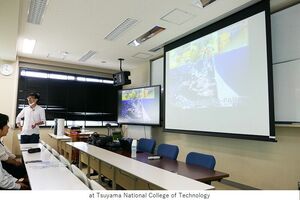 |
 |
■Director made a lecture at the Junior High School he graduated (July 14)
The J-PARC Director, Takashi Kobayashi, gave a lecture at his alma mater, Ochiai Junior High School in Maniwa City, Okayama Prefecture with a total of about 300 students. Ochiai Junior High School is located in a quiet mountainous area in the northern part of Okayama Prefecture. Almost all the students gathered in the auditorium to listen to the lecture titled "Secrets of the Big Universe, Secrets of the Microscopic World, and Accelerators."
After explaining the size of the universe, Dr. Kobayashi talked about small elementary particles and explained that an accelerator is needed to see elementary particles. He then introduced J-PARC's features and role as the world's most powerful accelerator. He shared a story about how he fell in love with science through a science comic book and borrowed books from the Ochiai Community Center library, sending the message that he hopes this class will spark everyone's interest in science.
 |
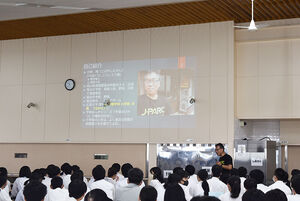 |
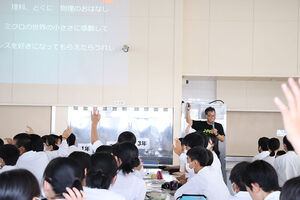 |
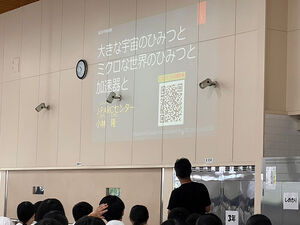 |
■Eco Fes Hitachi 2023 (July 22, at Hitachi Civic Center)
J-PARC Center exhibited at "Eco Fes Hitachi 2023 - Let's find out what we can do to create a 'decarbonized city'" held by Hitachi City at Hitachi Civic Center. Eco Fes Hitachi is an event where people can learn about environmental issues through experiments and hands-on experiences. About 250 people visited the J-PARC Center's booth despite the scorching weather. The superconducting coaster created by the Cryogenics Section of J-PARC Center was the most popular attraction this year, also. Superconductors cooled down to nearly -200℃ glided along the rails like a roller coaster while levitating a few mm above the magnetic rails. When J-PARC staff explained that this superconducting technology is also used in the accelerator facilities at J-PARC, some visitors said they would love to visit and see the accelerator facilities in person.
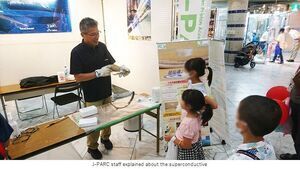 |
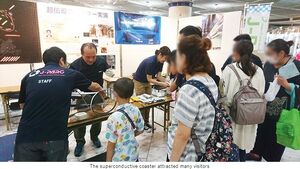 |
■Tokai-mura Enjoy Summer School 2023 (July 25, August 1 and 9 at Tokai-mura Library)
Tokai-mura Board of Education organized "Enjoy Summer School" for elementary school students in the village. The J-PARC Center held a series of experimental classes titled "Let's make a spinning top that spins while tilted!" Thirty-seven students joined them for three days in total.
Even when the magnets and coils were separated, the children observed how they interacted with each other due to the flowing current.On crafting spinning tops, children investigated how the motion of the spinning axis, precession, changed when the center of gravity was changed. Then, they were into finding the center of gravity position where the precession did not occur.
The elementary particles studied at J-PARC move like spinning tops under the influence of magnetic forces. We hope students took this opportunity to learn that many phenomena can be connected to science if we carefully observe familiar objects.
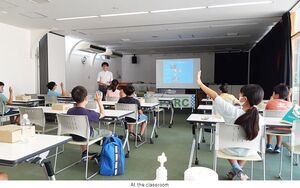 |
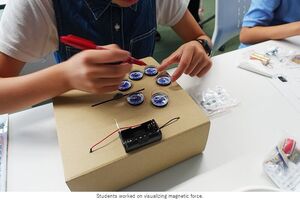 |
 |
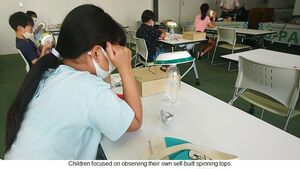 |
■Joint Project “Muographic Investigation of Ancient Burial Mounds in Tokai”
- Children observed cosmic ray muons with self-built detectors (August 3rd, 6th, 8th)
Thirty-one students of elementary through high schools experienced building muon detectors, and they succeeded in observing the cosmic ray muon with their self-built detectors. This event was held on August 3rd, 6th, and 8th at Tokai village museum, as the 5th in a series of joint projects between Tokai Village, J-PARC Center, Ibaraki University, and Tokyo Metropolitan University.
When a cosmic ray collides with the Earth's atmosphere, muons are created and travel to the ground. They emit light as they pass through the scintillator. The light is collected with an optical fiber, detected by a photo-sensor, and measured with an oscilloscope.
First, the attendees passed an optical fiber through each of two transparent plastic scintillator plates and covered them entirely with a black sheet. Next, they assembled the circuit, connected the cable from the photo-sensor to the readout board, and wired it up to the oscilloscope. The processes ranged from the large-scale assembly of scintillators nearly one meter long, to the delicate work of connecting small circuits, and adjusting the oscilloscopes used for cutting-edge experiments at J-PARC. Due to the complexity of the process, in addition to the staff of the Community House and J-PARC, students from Ibaraki University also participated as supporting staff, and the children received advices from them while working on this program.
The two blue and yellow lines in the oscilloscope in the last photo are signals from the optical fibers in the two scintillators. Both pulses indicate that cosmic ray muons have been detected. Since the two scintillators emit light simultaneously, this shows that they are capturing cosmic ray muons and not just noise.
It was a new experiment for the organizers to have the children build their own detectors and use them to measure cosmic ray muons. This must have been a very valuable experience for the children.
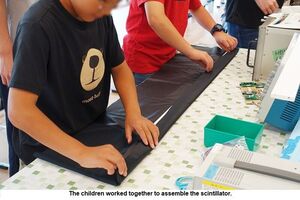 |
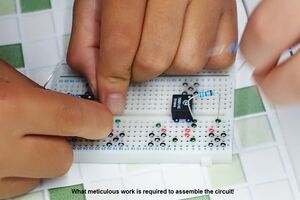 |
 |
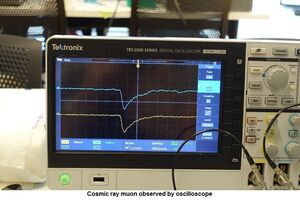 |
■Sanpomichi #37 -Scorpios and Anti-Scorpios-
This photo is of the summer night sky taken from Lake Sohara in Urabandai. The location is at a high altitude, and there are almost no lights around so you can find stars down to 6th magnitude with the naked eye. In addition, the Milky Way passes over Mt. Bandaisan with so many stars visible that it is difficult to see Scorpius in the sky. Instead, the surface of the lake erases the extra stars, and only the main stars from the reddish first magnitude star Antares to the tail of Scorpius are reflected in a beautiful inverted S-curve, making it clear that the stars in the sky are the constellation Scorpius.
The photographer humbly says, "This photograph is the result of chance.” However, to take this picture, all the conditions had to be right: the season, the time of day, the humidity, the atmospheric pressure, the presence of the moon, and the brightness of the cities of Aizu Wakamatsu and Koriyama stretching beyond the horizon.
When the universe was born, an equal amount of matter and antimatter were created, then matter and antimatter collided and destroyed each other, but in the current universe antimatter has almost disappeared and only matter remains. Matter and antimatter are not perfectly symmetrical, and there seems to be a difference somewhere. To confirm the identity of this difference, J-PARC is investigating CP violation.
It is like that Scorpius in the sky and Scorpius Anti-Scorpius reflected on the lake's surface symbolize CP symmetry breaking. J-PARC will pursue the grand romance of the story of the creation of the universe by creating a large number of particles and antiparticles and studying the differences in their decay and other changes.

